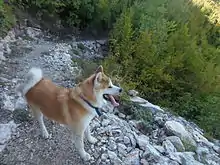Akita (dog)
The Akita (秋田, Akita, Japanese pronunciation: [akʲita]) is a Japanese dog breed of large size. Originating from the mountains of northern Japan, the Akita has a short double coat similar to that of many other northern spitz breeds. Historically, they were used by matagi for guarding and the hunting of bears.
| Akita | |||||||||||||||||||||||||||||||||
|---|---|---|---|---|---|---|---|---|---|---|---|---|---|---|---|---|---|---|---|---|---|---|---|---|---|---|---|---|---|---|---|---|---|
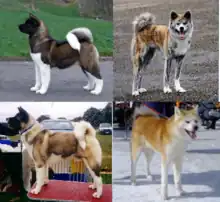 | |||||||||||||||||||||||||||||||||
| Other names |
| ||||||||||||||||||||||||||||||||
| Origin | Japan | ||||||||||||||||||||||||||||||||
| |||||||||||||||||||||||||||||||||
| |||||||||||||||||||||||||||||||||
| Notes | National dog of Japan, Prefecture animal of Akita | ||||||||||||||||||||||||||||||||
| Dog (domestic dog) | |||||||||||||||||||||||||||||||||
The Akita is a powerful, dominant and loyal breed, commonly aloof with strangers, but affectionate and deeply loyal with its family. As a breed, Akitas are generally hardy. The two separate varieties of Akita are a pure Japanese strain, called Akita Inu or Akita-ken, and a larger mixed strain, commonly referred to as the "American Akita".[2] However, it is subject to debate as to whether the Akita strains are distinct, or if they constitute one, single breed.[3][4][5]
Breed name
Debate exists among fanciers whether these are two separate breeds of Akitas. As of 2020, the American Kennel Club,[6] now considers American and Japanese Akitas to be two separate breeds, no longer allowing free breeding between the two. The United Kennel Club,[7] the Federation Cynologique Internationale (FCI),[8] The Kennel Club,[9][10] the Australian National Kennel Council,[11] the New Zealand Kennel Club,[12][13] and the Japan Kennel Club[14] consider Japanese and American Akitas as separate breeds.[15] Some countries refer to the American Akita as simply the Akita and not the American Akita. The issue is especially controversial in Japan.[16] For the FCI's 84 countries, the breed split formally occurred June 1999, when the FCI decided that the American type would be called the Great Japanese Dog,[15] later renamed the American Akita in January 2006.[15]
History
Japanese history
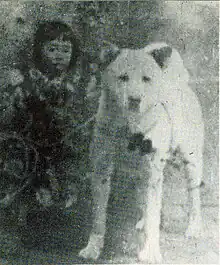
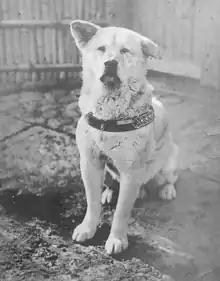
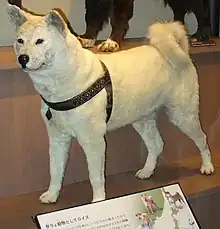
The Akita Inu originated in the snowy and rural lands of Odate, Akita Prefecture, a wild and mountainous region of Japan. They were trained to hunt animals such as elk, wild boar, and Ussuri brown bears.[17] This breed in the 1600s was involved in dog fighting, which at the time was popular in Japan. From the 1500s into the 1800s, the Akita served as companions for samurai.[18]
In 1931, the Akita was officially declared a Japanese natural monument. The mayor of Odate City in Akita Prefecture organized the Akita Inu Hozonkai to preserve the original Akita as a Japanese natural treasure through careful breeding.[19]
In 1933, Heishiro Takaku (Takahisa), one of the early members of Nippo in Tokyo and later of the Nipponinu Kyokai (Nikkyo) in Osaka and Katsuichi (Shoichi) each published articles on a proposed Japanese dog standard, which Included the Akita dog. Akita dogs revealed the most non-uniformity at that time, when compared to medium and small Japanese dogs, due to being outcrossed to the Tosa fighting dog, and other Imported foreign dogs.[20] Then in 1934, the first Japanese breed standard for the Akita Inu was listed, following the breed's declaration as a natural monument of Japan.[21]
The Akita breed was used during the Russo-Japanese War to track prisoners of war and lost sailors.[22] During World War II, the Akita was considered a non-military breed and was crossed with German Shepherds in an attempt to save them from the wartime government order for all non-military dogs to be culled.[23] Some were used as scouts and guards during the war.[22]
A native Japanese breed known as Matagi (hunting dog) was used along with the Hokkaido Inu breed to mix back into the remaining Akita dogs to restore the breed. There were many lines of Akita, but the most influential were the Dewa and Ichinoseki. [24] Both lines contributed to the foundation stock for both Akita types, and many exported dogs were a combination of these lines. According to one Japanese judge, the greatest difference between Japanese- and American-bred Akitas is that the latter still show much evidence of the Dewa strain.[25] In the early 1900's, Dewa-line akitas were heavily favored and did well in show. Kongo-go (from the Heirakudo Kennel of Eikichi Hiraizumi) is considered to be the most influential dog of that line. For a time, it was said: “Kongokei ni arazunba Akitainu ni arazu" (If not from the Kongo line, ‘tis not an Akita dog.)[26]
However, the Dewa-line later went into a decline because Japanese breeders felt that the akita did not give the impression of a Japanese dog, so began to breed towards an ideal type reminiscent of other Nihon-ken. The Dewa line was stereotyped as the “German Shepherd” type, while the Ichinoseki line was referred to as the “Mastiff” type.[24][26] Thus, the Ichinoseki-line rose in popularity. Goromaru-Go was regarded as the most influential akita of that line who, although didn't perform well in show, produced outstanding akita dogs when bred to Taihei and Nikkei lines from Southern Akita. Goromaru-Go then became foundation to further the Japanese type.
During the occupation years following the war, the breed began to thrive again through the efforts of Sawataishi and others.[18] Morie Sawataishi and his efforts to breed the Akita is a major reason this breed exists today.[27] For the first time, Akitas were bred for a standardized appearance.[28] Akita fanciers in Japan began gathering and exhibiting the remaining Akitas and producing litters to restore the breed to sustainable numbers and to accentuate the ideal characteristics of the breed muddied by crosses to other breeds.[29] It wasn't until the 1960-70's where the foxier Japanese type started to diverge from the typical American type.[30]
The story of Hachikō, the most revered Akita of all time, helped push the Akita into the international dog world. Hachikō was born in 1923 and owned by Professor Hidesaburō Ueno of Tokyo.[31] Professor Ueno lived near the Shibuya Train Station in a suburb of the city, and commuted to work every day on the train.[19] Hachikō accompanied his master to and from the station each day.[19] On May 25, 1925, when the dog was 18 months old, he waited for his master's arrival on the four o'clock train, but Professor Ueno had suffered a fatal brain haemorrhage at work.[19] Hachikō continued to wait for his master's return.[19] He travelled to and from the station each day for the next nine years.[19] He allowed the professor's relatives to care for him, but he never gave up the vigil at the station for his master.[19] His vigil became world-renowned when, in 1934,[32] shortly before his death, a bronze statue was erected at the Shibuya train station in his honor.[19] This statue was melted down for munitions during the war, but a new one was commissioned after the war.[32] Each year on March 8 since 1936, Hachikō's devotion has been honoured with a solemn ceremony of remembrance at Tokyo's Shibuya railroad station.[33][34] Eventually, Hachikō's legendary faithfulness became a national symbol of loyalty, particularly to the person and institution of the Emperor.[35]
In 1967, commemorating the 50th anniversary of the founding of the Akita Dog Preservation Society, the Akita Dog Museum was built to house information, documents and photos.[19] There is a tradition in Japan, that when a child is born they receive a statue of an Akita. This statue symbolizes health, happiness, and a long life.[36]

In 1937, Helen Keller travelled to Japan. She expressed a keen interest in the breed and was presented with the first two Akitas to enter the US.[37] The first dog, presented to her by Mr. Ogasawara and named Kamikaze-go, died at 7+1⁄2 months of age from distemper, one month after her return to the States. A second Akita was arranged to be sent to Miss Keller: Kamikaze's litter brother, Kenzan-go.[38] Keller nicknamed the dog Go-Go and they were great companions from day one. Go-Go even spent his first night at Keller’s home sleeping at the foot of her bed.[39] Kenzan-go died in the mid-1940s.[40] By 1939, a breed standard had been established and dog shows had been held, but such activities stopped after World War II began. Keller wrote in the Akita Journal:
If ever there was an angel in fur, it was Kamikaze. I know I shall never feel quite the same tenderness for any other pet. The Akita dog has all the qualities that appeal to me he is gentle, companionable and trusty.[41][42]
American history
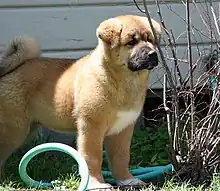

The Japanese Akita and American Akita began to diverge in type during the post-World War II era due to America and Europe preserving the akitas that fell out of favour with the Japanese, particularly the Dewa-types and dogs with the signature black mask or pinto marking. American Akitas are typically considered mixed by Japanese breeders (and not true Akitas by the Japanese standard)[43] however, their phenotype predates the Japanese akita by a few decades, thus being closer to pre-war akitas like Hachiko.[30]
Helen Keller is credited with bringing the Akita to America after being given two Akitas by the Japanese government in 1938. By 1939, a breed standard was established, and dog shows began to be held, but this development was interrupted by World War II.[44] During this time, US servicemen serving as part of the occupation force in Japan first came into contact with the Akita, the breed so impressed them that many service members chose to bring an Akita back home with them upon completion of their tour.
Although both types derive from common ancestry, marked differences are seen between the two.[45] American Akitas generally are heavier boned and larger, with a more bear-like head, whereas Japanese Akitas tend to be lighter and more finely featured with a fox-like head.[15] Additionally, while American Akitas are acceptable in all colors, Japanese Akitas are only permitted to be red, white, or brindle. Additionally, American Akitas may be pinto and/or have black masks, unlike Japanese Akitas, where these are considered disqualifications and are not permitted in the breed standards.
Recognized by the American Kennel Club in 1955, the Akita was placed in the Miscellaneous class. The AKC did not approve the Akita standard until 1972, and it was moved to the Working Dog class. As such, the Akita is a rather new breed in the United States. Foundation stock in America continued to be imported from Japan until 1974, when the AKC cut off registration to any further Japanese imports until 1992, when it recognized the Japan Kennel Club standards. This decision set the stage for the divergence in type between the American Akita and Japanese Akita Inu that is present today.[46]
Elsewhere in the world, one American Akita was first introduced to the UK in 1937. He was a Canadian import, owned by a Mrs. Jenson; the descendants of Mrs. Jenson live on today breeding American Akitas. The most widely known of these is Mr. Joseph Felton, an award-winning Akita breeder, but the breed was not itself widely known until the early 1980s.[40] The breed was introduced in Australia in 1982 with an American import and to New Zealand in 1986 with an import from the UK.[40]
Gallery
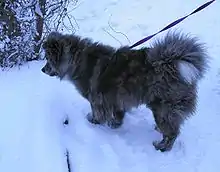
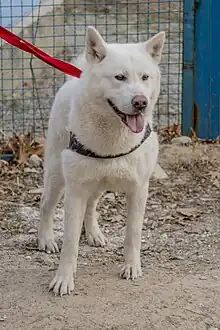
.jpg.webp)
Appearance
As a spitz breed, the appearance of the Akita reflects cold-weather adaptations essential to their original function.[47] The Akita is a substantial breed for its height with heavy bones.[48] Characteristic physical traits of the breed include a large, bear-like head with erect, triangular ears set at a slight angle following the arch of the neck.[48] Additionally, the eyes of the Akita are small, dark, deeply set, and triangular in shape.[49] Akitas have thick double coats, and tight, well-knuckled, cat-like feet.[48] Their tails are carried over the tops of their backs in a gentle or double curl down the loin.[50]
Mature American-type males measure typically 26-28 in (66–71 cm) at the withers and weigh between 100 and 130 lb (45–59 kg).[48] Mature females typically measure 24-26 in (61–66 cm) and weigh between 70 and 100 lb (32–45 kg).[51] The Japanese type, as stated in the breed standards, is a little smaller and lighter.
Breed standards state that all dog breed coat colors are allowable in the American Akita, including pinto, all types of brindle, solid white, black mask, white mask, self-colored mask, and even differing colors of undercoat and overlay (guard hairs).[52] This includes the common Shiba Inu coloring pattern known as urajiro.[53] The Japanese Akitas, as per the breed standards, are restricted to red, fawn, sesame, brindle, and pure white, all with urajiro markings - whitish coat on the sides of the muzzle, on the cheeks, on the underside of jaw, neck, chest, body, and tail, and on the inside of the legs.[9]
Coat types
The two coat types in the Akita are the standard coat length and the long coat.[54][55] The long coat is considered a fault in the show ring, however.[54][55] The long coat, also known as moku, is the result of an autosomal recessive gene and may occur phenotypically only if both sire and dam are carriers. They have longer (about 3-4 in long) and softer coats[56] and are known to have sweeter temperaments.[54][55] This gene is thought to come from the recently extinct Karafuto Ken samurai dog.[57]
Grooming needs
American Akitas are a low-maintenance dog breed. They tend to groom themselves like a cat.[58] Grooming them should be an easy process. They are fairly heavy shedders and can go heavier than normal two to three times per year. Specifically, Akitas "blow out" their coats twice a year.[59][60][61][62] Daily brushing could be a good way to reduce this problem.[59] This breed needs to bathe every few months, although it can be more often, depending on the needs of each owner. Toenails should be trimmed every month, and their ears should be cleaned once a week.
Temperament
The Akita is generally seen as territorial about its property, and can be reserved with strangers.[63][64] It is sometimes described as feline in its actions; not unusually, an Akita may clean its face after eating, preen its kennel mate, and be fastidious in the house.[65] It is known to be intolerant of other dogs of the same sex, as stated in the AKC breed standard.[6]
Since it is a large, powerful dog, the Akita is not considered a breed for a first-time dog owner.[63][64] The breed has been defined in some countries' breed-specific legislation as a dangerous dog.[66][67][68][69] The Akita is a large, strong, independent, and dominant dog. A well-trained Akita should be accepting of nonthreatening strangers, otherwise they treat all strangers in an aggressive manner.[70] As a breed, they should be good with children; the breed is said to have an affinity for children.[71] Not all Akitas necessarily have the same temperament.[72][upper-alpha 1]
Akitas tend to be reactive towards other dogs, so caution must be used in situations when Akitas are likely to be around other dogs, especially unfamiliar ones. In particular, Akitas tend to be less tolerant of dogs of the same sex.[64] For this reason, Akitas, unless highly socialized, are not generally well-suited for off-leash dog parks.[65] Sometimes spontaneous, it needs a confident, consistent handler, without which the dog will be very willful and may become very aggressive to other dogs and animals.[72]
Health
Autoimmune diseases
Many autoimmune diseases are known to occur in the Akita, including:
- Vogt–Koyanagi–Harada syndrome,[75][76] also known as uveo-dermatologic syndrome, is an autoimmune condition that affects the skin and eyes.[77]
- Autoimmune hemolytic anemia[78] is an autoimmune blood disorder.[79]
- Sebaceous adenitis[80][81][82] is an autoimmune skin disorder believed to be of autosomal recessive inheritance.[80]
- Pemphigus foliaceus[83] is an autoimmune skin disorder, believed to be genetic.[84]
- Systemic lupus erythematosus, or lupus, is a systemic autoimmune connective-tissue disease that can affect any part of the body.[85]
Immune-mediated endocrine diseases
In addition to these, some immune-mediated endocrine diseases with a heritable factor can occur, such as:
- Hypoadrenocorticism, also known as Addison's disease, affects the adrenal glands and is essentially the opposite of Cushing's syndrome.[86]
- Diabetes mellitus, also known as type 1 diabetes, affects the pancreas.[86]
- Hypothyroidism,[87] also known as autoimmune hypothyroidism, is an autoimmune disease that affects the thyroid gland.[88]
Nonimmune-specific conditions
Other nonimmune-specific conditions known to have occurred in the Akita include:
- Gastric dilation, also known as bloat may progress to gastric dilatation volvulus, in which the stomach twists on itself.[89]
- Microphthalmia, meaning "small eyes", is a developmental disorder of the eye, believed to be an autosomal recessive genetic condition.[90]
- Primary glaucoma,[91] results increased pressure within the eyeball.[92]
- Progressive retinal atrophy[91][93] is a progressive degeneration of the retina (portion of the eye that senses light and allows sight).[92]
- Hip dysplasia[78] is a skeletal condition where the head of the femur does not fit properly into the hip socket it leads to osteoarthritis and pain.[94]
- Elbow dysplasia[78] is a skeletal condition in which the components of the elbow joint (the humerus, radius, and ulna) do not line up properly, leading to osteoarthritis and pain.[95]
- Von Willebrand disease,[96][97][98] is a genetic bleeding disorder caused by a deficiency in Von Willebrand factor.[99]
- Cushing's syndrome, also known as hyperadrenocorticism, affects the adrenal glands, and is caused by long-term exposure to high levels of glucocorticosteroids, either manufactured by the body or given as medications.[86]
Breed-specific conditions
These breed-specific conditions are mentioned in veterinary literature:
- Immune sensitivity to vaccines, drugs, insecticides, anesthetics, and tranquilizers
- Pseudohyperkalemia is a rise in the level of potassium that occurs due to its excessive leakage from red blood cells (RBCs) when blood is drawn. This can give a false indication of hyperkalemia on lab tests, hence the prefix pseudo, meaning false.[85] This occurs because many East Asian breeds, including Akitas and Shiba Inus, have a higher level of potassium in their RBCs than other dogs.[100]
Working life
Predecessors of the modern Akita were used for hunting bear, wild boar, and deer in Japan as late as 1957.[101] They would be used to flush out the boar and keep it at bay until the hunter could come and kill it. Today, the breed is used primarily as a companion dog, but is currently also known to be used as therapy dogs,[102] and compete in all dog competitions, including conformation showing, obedience trials, canine good-citizen program, tracking trials, and agility competition,[103] as well as weight pulling, hunting, and Schutzhunde (personal protection dogs).[104]
See also
References
Citations
- Cassidy, Kelly M. (February 2008). "Breed Longevity Data". Retrieved September 18, 2012.
- "American Akita". 17 December 2019.
- "The Loyal, Bear-Hunting Akita". Japan Powered. 2020-09-27. Retrieved 2022-05-24.
- Brearley, Joan McDonald (1985). The Book of the Akita. TFH. pp. 4–7. ISBN 0866220488.
- "Akita | Breeds A to Z | The Kennel Club". www.thekennelclub.org.uk. Retrieved 2022-05-24.
- "Akita Breed Standard" (website). American Kennel Club. Archived from the original on 14 May 2011. Retrieved 20 February 2021.
- "Breed Standards" (website). United Kennel Club. Retrieved 14 November 2016.
- "FCI standard #344, American Akita". Federation Cynologique Internationale. Archived from the original (document) on 15 May 2006. Retrieved 9 March 2011.
- "UK Breed Standard for Japanese Style". The Kennel Club. Archived from the original (website) on 14 August 2020. Retrieved 15 October 2011.
- "UK Breed Standard for American Style". The Kennel Club. Archived from the original (website) on 14 August 2020. Retrieved 15 October 2011.
- "Australian Breed Standard". Australian National Kennel Council. Archived from the original (website) on 2015-02-28. Retrieved 22 December 2016.
- "NZ Standard for American Style". New Zealand Kennel Club. Archived from the original (website) on 24 May 2011. Retrieved 19 April 2011.
- "NZ Standard for Japanese Style". New Zealand Kennel Club. Archived from the original (website) on 24 May 2011. Retrieved 19 April 2011.
- "一般社団法人 ジャパンケネルクラブ" (in Japanese). Retrieved 2021-09-24.
- Kaluzniacki, Sophia. "The Akita Dilemma – One Breed or Two?: a historical perspective" (website). Tamarlane. Retrieved 19 May 2011.
- Itagaki, Dr. Shiro. "The Preservation and Development of Japanese Dogs" (PDF). Akita Learning Center. Retrieved 6 May 2011.
- Bouyet, Barbara (1992). Akita, Treasure of Japan. Japan: MIP Publishing.
- "Morie Sawataishi: Saviour of Japan's Akita Samurai dog" (website). The Daily Telegraph. Japan. 11 December 2008. Archived from the original on 2022-01-12. Retrieved 6 May 2011.
- Chida, Hiroshi (27 November 2003). "Odate museum honors national dog, the Akita". Stripes Pacific Travel. Stars and Stripes. Retrieved 30 April 2011.
- "History of the Akita | Minamoto No Yorimitsu". www.m-n-y-akitas.nl. Retrieved 2022-10-09.
- Andrews, Barbara J. (1996). Akitas. N.J. USA: T.F.H. Publications Inc. p. 17. ISBN 0-7938-2760-4.
- Allsopp, Nigel (2012). K9 Cops: Police Dogs of the World. Big Sky Publishing.
- "Akita Inu Breed History". Japanese Akita Inu Club Great Britain. Archived from the original on 13 January 2012. Retrieved 29 April 2011.
- "History Of The Akita Inu: 1 Of The Great Japanese Breeds - A Dog's Game". adogsgame.com. 2023-05-06. Retrieved 2023-05-13.
- "Website_Caccia - Akita". www.caccia.se. Retrieved 2022-09-20.
- "History of the Akita | Minamoto No Yorimitsu". www.m-n-y-akitas.nl. Retrieved 2022-10-09.
- Sherrill, Martha (28 February 2008). Dog Man: An Uncommon Life on a Faraway Mountain. City: Penguin Press USA. p. 256. ISBN 978-1-59420-124-0. ISBN 978-1-59420-124-0
- "AKIKO". www.clubakita.ro. Retrieved 2018-02-07.
- Kimura, Tatsuo. "A History Of The Akita Dog" (website). Akita Learning Center. Retrieved 6 May 2011.
- "Akita Pedigree". www.akitapedigree.com. Retrieved 2022-10-09.
- Killilea, David; Jenny Killilea (1988). The Akita Today. Glouchestershire, UK: Ringpress Books Ltd. pp. 15–16. ISBN 1-86054-099-6.
- Andrews, Barbara J. (1996). Akitas. N.J. USA: T.F.H Publications Inc. pp. 21–22. ISBN 0-7938-2760-4.
- American Kennel Club (listed author): The Complete Dog Book: The Photograph, History, and Official Standard of Every Breed Admitted to AKC Registration, and the Selection, Training, Breeding, Care, and Feeding of Pure-bred Dogs, Howell Book House, 1985, page 269. ISBN 0-87605-463-7.
- Ruthven Tremain, The Animals' Who's Who: 1,146 Celebrated Animals in History, Popular Culture, Literature, & Lore, Scribner, 1984, page 105. ISBN 0-684-17621-1. Accessed via Google Books August 21, 2008.
- Skabelund, Aaron Herald (23 September 2011). "Canine Imperialism". Berfrois. Retrieved 28 October 2011.
{{cite journal}}: Cite journal requires|journal=(help) - "Akita History & Training/Temperament". www.akc.org. American Kennel Club. Retrieved 2016-09-20.
- "Helen Keller: First Akitas in the USA". Natural-akita.com. June 14, 1937. Retrieved August 24, 2010.
- Ogasawara, Ichiro. "Helen Keller and Akitas". Akita Learning Center. Retrieved 7 May 2011.
- Gibeault, Stephanie. "Hellen Keller, Accomplished & Inspirational Icon, Was a Lifelong Dog Lover". American Kennel Club. Retrieved 2022-02-10.
- Killilea, David; Killilea, Jenny (1998). The Akita Today. Glouchester, U.K.: Ringpress. ISBN 1-86054-099-6.
- Rick Beauchamp. "The Akita Inu: The Voice of Japan". Dog & Kennel. Archived from the original on 2011-07-18. Retrieved 6 August 2011.
- "Helen Keller: First Akitas in the USA". Natural-akita.com. 14 June 1937. Retrieved 24 August 2010.
- "Akita Inu". Japanesedogs. Archived from the original on 20 November 2020. Retrieved 5 November 2019.
- "Helen Keller". Akita Club of America. Retrieved 2018-02-25.
- "The Two Akitas". DogChannel.com. Archived from the original on 2015-07-14. Retrieved 2015-07-13.
- "Akita Inu". starpetstore.com/. Archived from the original on 2021-09-24. Retrieved 2021-09-24.
- "Akita: Physical Characteristics". Pet MD.
- The Complete Dog Breed Book: Choose the Perfect Dog for You. Penguin. 2020-03-17. ISBN 978-0-7440-2234-6.
- Wallis, Sherry (20 January 2011). "Akita proportions". Dogs in Canada. Archived from the original on 2011-09-27. Retrieved 3 May 2011.
- "American Kennel Club – Akita" (website). American Kennel Club. Archived from the original on 13 February 2015. Retrieved 17 April 2011.
- "Akita – Canada's Guide to Dogs" (website). Canada's Guide to Dogs. Archived from the original on 14 May 2011. Retrieved 17 April 2011.
- "Akita Colors" (website). Tarmalane. Retrieved 17 April 2011.
- "Shiba Inu Appearance – My First Shiba Inu". 14 January 2016. Retrieved 2022-01-21.
- "The Long Coat Akita: A Wonderful Variation - A Dog's Game". adogsgame.com. 2023-04-29. Retrieved 2023-05-13.
- Taylor, Jason (1996). Guide to Owning an Akita. United States: TFH Publications. p. 21. ISBN 0-7938-1878-8.
- "Long Coat Akitas". DoubleTake. Archived from the original (website) on 2011-09-30. Retrieved 17 April 2011.
- Andrews, Barbara J. (1996). Akitas. NJ, United States of America: TFH Publications Inc. p. 16. ISBN 0-7938-2760-4.
- Bovsun, Mara (October 15, 2015). "10 Surprising Facts About Akitas". American Kennel Club. Retrieved 2020-07-30.
- "The Ultimate Grooming Guide For Akitas: Tips, Tools, And Techniques - A Dog's Game". adogsgame.com. 2023-05-01. Retrieved 2023-05-13.
- "Do Akitas Shed? — Hoka-Hey.com". Archived from the original on 2019-05-28. Retrieved 2019-11-21.
- "Akita Grooming/Washing tips". Akita World. 2013-04-07. Retrieved 2019-11-21.
- Fantegrossi, Dina (10 November 2017). "What Is Coat Blow & Will It Affect Your Dog?". iheartdogs.com. Retrieved 2019-11-21.
- "Japanese Akita Inu Vs. American Akita: What Should You Know? - A Dog's Game". adogsgame.com. 2023-04-17. Retrieved 2023-05-13.
- "Japanese Akita temperament and training | Pets4Homes". Pets4Homes. Retrieved 2018-02-23.
- "The Akita: Is The Akita the Right Dog For You?". Akita Club of America Inc. Archived from the original (website) on 2011-04-20. Retrieved 19 April 2011.
- "Anti-Canine Legislation Information". Akita Club of America. Archived from the original (website) on 10 June 2011. Retrieved 30 April 2011.
- "Changes to NYCHA's Pet Policy" (PDF). New York City Housing Authority Journal. New York City Government. 39 (4). April 2009. Archived from the original (PDF) on 11 January 2012. Retrieved 17 April 2011.
- "Restricted Dog Breeds". Bermuda Minister of the Environment. Archived from the original (website) on 2011-06-08. Retrieved 26 May 2010.
- "Dangerous Dogs". Department of Environment, Heritage, and Local Government. 2007. Archived from the original (website) on 2009-06-29. Retrieved 16 August 2009.
- "Akita Inu Dog Breed – Temperament & Personality". 3 August 2015. Archived from the original on 23 February 2018. Retrieved 23 February 2018.
- Wallis, Sherry E. "Akita Temperament" (website). Tarmalane. Retrieved 1 May 2011.
an Akita should like children. Just as retrievers like sticks and balls, this breed should have an affinity for children.
- Wallis, Sherry E. "Akita Behavior & Temperament" (website). Tarmalane. Retrieved 4 October 2011.
- "Dog that mauled volunteer will be euthanized, tested for rabies". www.azcentral.com. 2017-12-21.
Akita Advocates identified the fatally wounded woman as Carol Harris, a volunteer, and said she was attacked Wednesday 'while helping to rehab an orphaned Akita in the hopes of him becoming adoptable.'
- "Woman working to rehabilitate orphaned dog mauled to death". www.kcra.com. KCRA. 2017-12-22.
'[Carol Harris] passed away while helping rehab an orphaned Akita in the hopes of him becoming adoptable,' Akita Advocates wrote on their Facebook page.
- Angles, J. M.; Famula, T. R.; Pedersen, N. C. (2005). "Uveodermatologic (VKH-like) syndrome in American Akita dogs is associated with an increased frequency of DQA1*00201". Tissue Antigens. 66 (6): 656–65. doi:10.1111/j.1399-0039.2005.00508.x. PMID 16305682.
- Cottelll, Beverley D.; Barnett, K. C. (1987). "Harada's disease in the Japanese Akita". Journal of Small Animal Practice. 28 (6): 517–21. doi:10.1111/j.1748-5827.1987.tb01445.x.
- Monaco, Marie. "Uveodermatologic Syndrome (UDS, VKH)". Samoyed Club of America. Retrieved 8 October 2011.
- "Diseases of The Japanese Akita-Inu". Japanese Akita Club of America. Archived from the original on 2014-12-29. Retrieved 22 December 2016.
- Day, M.J (1999). "Antigen specificity in canine autoimmune haemolytic anaemia". Veterinary Immunology and Immunopathology. 69 (2–4): 215–24. doi:10.1016/S0165-2427(99)00055-0. PMID 10507306.
- Reichler, Iris M.; Hauser, Beat; Schiller, Irene; Dunstan, Robert W.; Credille, Kelly M.; Binder, Heinrich; Glaus, Toni; Arnold, Susi (2001). "Sebaceous adenitis in the Akita: Clinical observations, histopathology and heredity". Veterinary Dermatology. 12 (5): 243–53. doi:10.1046/j.0959-4493.2001.00251.x. PMID 11906649.
- Spaterna, A.; Antognoni, M.T.; Cappuccini, S.; Tesei, B. (2003). "Sebaceous Adenitis in the Dog: Three Cases". Veterinary Research Communications. 27: 441–3. doi:10.1023/B:VERC.0000014199.39879.bb. PMID 14535449. S2CID 30352408.
- Pedersen, Niels C. "Determining whether risk for sebaceous adenitis of Standard Poodles is associated with a specific DLA class II genotype" (PDF). Archived from the original (PDF) on 8 July 2011. Retrieved 22 April 2011.
- Kuhl, K. A.; Shofer, F. S.; Goldschmidt, M. H. (1994). "Comparative Histopathology of Pemphigus Foliaceus and Superficial Folliculitis in the Dog". Veterinary Pathology. 31 (1): 19–27. doi:10.1177/030098589403100103. PMID 8140722.
- "Pemphigus". The Akita Association (UK). Archived from the original (website) on 3 March 2016. Retrieved 22 April 2011.
- "Diseases in the American Akita" (PDF). Akita Rescue Mid-Atlantic Coast (USA). Archived (PDF) from the original on 2010-05-26. Retrieved 3 April 2011.
- Bouyet, Barbara; Meyers, Alicia; Eltinge, Steve; Dodds, Jean (2002). Akita, Treasure of Japan. Vol. 2. Thousand Oaks, California, USA: Magnum Publishing. pp. 268–269. ISBN 0-9716146-0-1. Retrieved 19 April 2011.
- Kennedy, L. J.; Quarmby, S.; Happ, G. M.; Barnes, A.; Ramsey, I. K.; Dixon, R. M.; Catchpole, B.; Rusbridge, C.; Graham, P. A.; Hillbertz, N. S.; Roethel, C.; Dodds, W. J.; Carmichael, N. G.; Ollier, W. E. R. (2006). "Association of canine hypothyroidism with a common major histocompatibility complex DLA class II allele". Tissue Antigens. 68 (1): 82–6. doi:10.1111/j.1399-0039.2006.00614.x. PMID 16774545. S2CID 358248.
- "The Akita – Diseases" (website). Akita Alumni Dog Club. Retrieved 19 April 2011.
- Bell, Jerold S. "Risk Factors for Canine Bloat". malamute health. Archived from the original (website) on 25 April 2012. Retrieved 4 October 2011.
- "Microphthalmia" (website). Canine Inherited Disorders Database. 1998. Retrieved 19 April 2011.
- Startup, F. (1986). "Hereditary eye problems in the Japanese akita". Veterinary Record. 118 (9): 251. doi:10.1136/vr.118.9.251-b. PMID 3705415. S2CID 30453180.
- Turner, Andrew; Hurn, Simon. "Eye Diseases and Information". All Animal Eye Services. Archived from the original (website) on August 5, 2009. Retrieved 19 April 2011.
- Clements, P. J. M.; Sargan, D. R.; Gould, D. J.; Petersen-Jones, S. M. (1996). "Recent advances in understanding the spectrum of canine generalised progressive retinal atrophy". Journal of Small Animal Practice. 37 (4): 155–62. doi:10.1111/j.1748-5827.1996.tb01950.x. PMID 8731401.
- "Treatment Options for Mature Canine Hip Dysplasia (Osteoarthritis stage)" (PDF). Colorado State University. Archived from the original (PDF) on 25 April 2012. Retrieved 8 October 2011.
- "Dog Joint Problems". JointPainInDogs.com. Archived from the original (website) on 2011-10-02. Retrieved 8 October 2011.
- Dodds, Jean (2005). "Bleeding Disorders" (website). World Small Animal Veterinary Association World Congress Proceedings. Retrieved 5 April 2011.
- "Von Willebrand Disease" (PDF). The Furry Critter Network. Archived from the original (PDF) on 2011-09-28. Retrieved 5 April 2011.
- Brooks, M. (1999). "A review of canine inherited bleeding disorders: Biochemical and molecular strategies for disease characterization and carrier detection" (PDF). Journal of Heredity. 90 (1): 112–8. doi:10.1093/jhered/90.1.112. PMID 9987916.
- Anderson, Julie B.; Latimer, Kenneth S.; Bain, Perry J.; Tarpley, Heather L. "Von Willebrand's Disease". Veterinary Clinical Pathology Clerkship Program. Archived from the original (website) on 2011-09-18. Retrieved 8 October 2011.
- Battison, Andrea (2007). "Apparent pseudohyperkalemia in a Chinese Shar Pei dog". Veterinary Clinical Pathology. 36 (1): 89–93. doi:10.1111/j.1939-165X.2007.tb00188.x. PMID 17311201.
- "Bear hunting in Japan 1957". Raritan River Akita Club inc. Archived from the original (website) on 19 February 2011. Retrieved 19 April 2011.
- "Working Akitas". Akita Network. Archived from the original (website) on 2012-01-11. Retrieved 4 October 2011.
- Andrews, Barbara J. (1996). "6 – Sport of purebred dogs". Akitas. N.J. USA: TFH Publications Inc. pp. 74–99. ISBN 0-7938-2760-4.
- Taylor, Jason (1996). Guide to Owning an Akita. N.J. USA: T.F.H. Publications Inc. p. 54. ISBN 0-7938-1878-8.
Further reading
- Skabelund, Aaron Herald (2011). Empire of Dogs: Canines, Japan, and the Making of the Modern Imperial World (A Study of the Weatherhead East Asian Institute (print). Ithaca, NY: Columbia University. ISBN 978-0-8014-5025-9. ISBN 080145025X
External links
 Media related to Akita Inu at Wikimedia Commons
Media related to Akita Inu at Wikimedia Commons- Akita World. Bimonthly Akita Magazine (archived 27 September 2011)
- Japanese Akita Club of America
